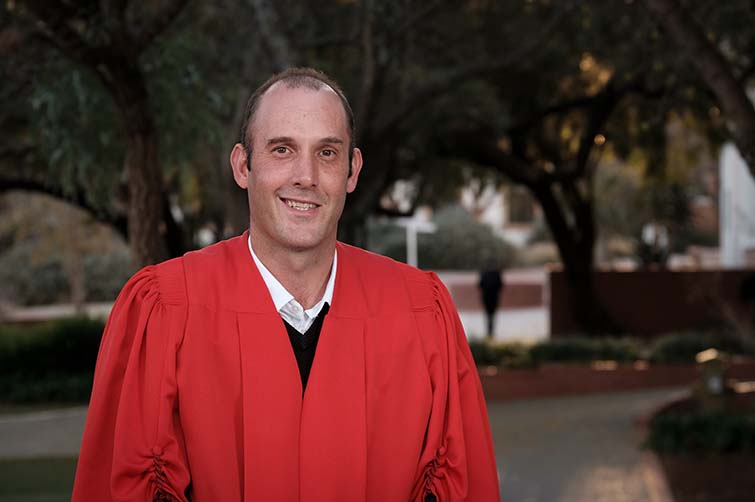21 August 2025
|
Story Martinette Brits
|
Photo Stephen Collett
 Prof Johan van Tol during his inaugural lecture, ‘Every Soil Has a Story to Tell’, at the University of the Free State on 18 August 2025.
Prof Johan van Tol during his inaugural lecture, ‘Every Soil Has a Story to Tell’, at the University of the Free State on 18 August 2025.
Prof Johan van Tol invited his audience on a journey through the hidden world beneath our feet during his inaugural lecture, Every Soil Has a Story to Tell, on Monday 18 August 2025. Using humour, personal anecdotes, and decades of research experience, he highlighted how understanding soils can guide sustainable land and water management while shaping the next generation of scientists.
Prof Van Tol, from the Department of Soil, Crop, and Climate Sciences, began with a humorous reflection on his high school band: “We were going to make it big. The only thing we needed was a name for the band, but we couldn’t agree on one. In the end, we didn’t make it big because we didn’t have a name for the band. A very positive spin-off is that tonight you are listening to a lecture and not to me singing.” He used this story as a metaphor for academia, explaining that just as a band needs a clear identity to succeed, academics benefit from taking stock of their work and reflecting on their direction. “It is really unique that one has the opportunity – and this is what I like so much about academia – to reflect on the past few years and decades and to say, this is what I have done so far, and also to reflect on what worked, what didn’t work, and what we should be doing in the future,” he said, emphasising the value of looking back in order to plan ahead.
The stories soils tell
He explained the principle behind the lecture’s title, inspired by Emeritus Professor Johan Bouma: “We, as soil scientists, need to speak on behalf of the soils; we must tell their story.” Using examples ranging from sandy, clayey, and loamy soils to soils with red, yellow, grey, and even green or blue tints, he emphasised that “each soil has its own story to tell” and that understanding these differences is crucial for planning, management, and sustainable resource use.
He shared a personal anecdote about his youngest son, who was learning about soils at school: “He said there are sandy soils, clayey soils, and loamy soils … and if you want good crop growth, you should rather use loamy soil instead of the rest.” Prof Van Tol explained that soil diversity goes far deeper, with subtle colour variations and structures revealing how water moves through the ground. For example, “If the iron is oxidised, the soils maintain their red colour. If the iron is reduced by water, you are left with grey soil. A grey colour in the soil indicates periods of significant saturation.”
A key focus of Prof Van Tol’s research is hydropedology, the study of interactions between soil and water. “Soil properties influence how water flows through them, and how the water flows through them – or stagnates in them – will in turn influence how the soils will look,” he explained. He highlighted practical applications, including informing land-use change approvals under the National Water Act, predicting microbial pollutant movement, and developing landslide early-warning systems in South Africa. He also cited the alpine research station in the Northern Drakensberg, describing it as “the highest station in Africa” and part of a long-term socio-ecological research platform that invites collaboration and offers a real-world example of studying soils in extreme environments.
Lessons, mentorship, and impact
Reflecting on his career, he emphasised mentorship and student development: “We often think that we are busy with research, but we are actually in the ‘people business’ – capacitating students. Every research paper is essentially just a progress report; lasting impact lies in how students are shaped.” He also spoke about commitment, patience, and long-term engagement in research and policy: “Even small actions, when carried out with sincerity and persistence, can create huge and lasting change.” Prof Van Tol encouraged adaptability and critical thinking, stressing that “the sheer number of publications will probably matter far less than the quality of research and the evidence of the real impact it provides.”
In conclusion, Prof Van Tol expressed gratitude to colleagues, friends, family, and mentors, dedicating the lecture to two late mentors and his father, acknowledging their profound influence on his life and career.
About Prof Johan van Tol
Prof Johan van Tol obtained his BSc (Agric) in Agronomy and Soil Science (2006), MSc in Soil Science (cum laude, 2008), and PhD in Soil Science (2011) from the University of the Free State. After completing his doctorate, he joined the University of Fort Hare as a lecturer, later senior lecturer, before returning to the UFS in 2016.
An NRF-rated scientist, Prof Van Tol has led or contributed to numerous nationally and internationally funded projects, focusing on hydropedology. His research has informed national water policy, and he has completed more than 100 consultancy projects providing practical soil solutions. He has published more than 90 scientific articles and book chapters and serves as an associate editor for Discover Soil and the South African Journal of Plant and Soil. Prof Van Tol is also a former President of the Soil Science Society of South Africa and chairs the Hydropedology Working Group of the International Union of Soil Sciences.